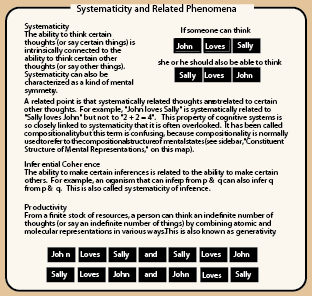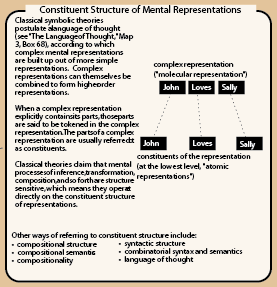Either: connectionism can’t account for systematicity and related phenomena (productivity, compositionality, and inferential coherence),
In which case: connectionism is inadequate as a theory of cognition.
Or, connectionism accounts systematicity and related phenomena by using structured representations,
In which case: connectionism is a mere implementation of the classical architecture.
In either case:
“
The mind cannot be, in its general structure, a connectionist network”, (Fodor & Pylyshyn, 1988, p.33), and the classical symbolic paradigm is still the best explanation of mind.
Jerry Fodor & Zenon Pylyshyn (1988) and Jerry Fodor & Brian McLoughlin (1990).
Spectrum of Positions—Implementationalism Implementationalism: The mind, in its general structure, is a symbolic processor. Connectionism is only useful as a theory of how those symbolic processes are implemented in the brain.
Proponents include:, Jerry Fodor, Zenon Pylyshyn, and Brian McLaughlin.
Revisionism: Symbolic accounts of mind will be exactly correct, after they have been revised on the basis of insights from connectionism. This position has been articulated by several authors but has not been explicitly endorsed by anyone.
Hybridism: Cognitive researchers should develop hybrid models that incorporate aspects of symbolic and connectionist architectures. This position is usually taken as a practical approach to modelling, not as a philosophical standpoint.
Proponents: Stan Kwasney, Kannaan Faisal, Trent Lange and Michael Dyer.
Eliminativism: Connectionism and neuroscience capture all important aspects of mind. High-level symbolic accounts of the mind should be eliminated from cognitive science.
Proponents: Stephen Stich, Patricia Churchland and Paul Churchland.
Cohabitationism: Connectionist and symbolic architectures cohabitate the mind. Connectionist networks perform low-level perceptual and motor tasks, which interface with a simple processor of the mind.
Proponents: John Barnden and Walter Schneider.
Ecumenicalism: It is necessary to incorporate “Everything that works” as we develop theories of mind. Connectionism, symbolicism, neuroscience, and perhaps other approaches will contribute to our understanding of how the mind operates. Ecumenicalism has been called “theoretical pluralism” by William James.
Proponents: Eric Dietrich and Chris Field, Robert van Gulick, Jay Rosenberg, and Gregory Stone.
Limitivism: Symbolic processes are approximations of lower-level symbolic (connectionist) activity, which is an abstraction from biological processes in the brain.
Proponents: Paul Smolensky.
Neural Eliminativism: The only relevant level of description of the mind is at the neural level. Even the connectionist and sub-symbolic accounts should be eliminated.
Proponents: Walter Freeman (to some extent).
Notes: These positions are discussed by Dinsmore (1992), Paul Smolensky (1998b, pp. 59-62), and Pinker and Prince (1988, pp.75-78).
Few theorists or researchers explicitly position themselves along the spectrum. Many fall into more than one of these categories or lie somewhere on the borders between them.

